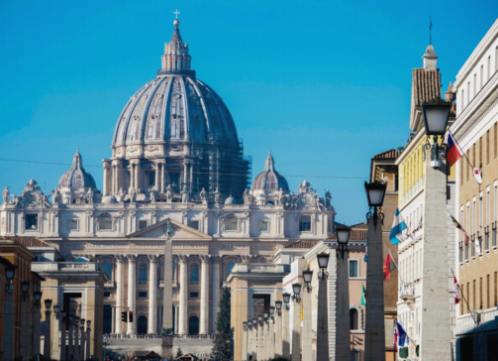The facade and portico of St. Peter's Basilica in Vatican City are not only magnificent architectural features, but also rich in symbolism and iconography. Through restoration efforts and a blend of Renaissance art influence, these structures stand as a testament to the grandeur and significance of this historic site.

Symbolism and Iconography on the Portico of St. Peter's Basilica
The Portico of St. Peter's Basilica is adorned with a wealth of symbolism and iconography that reflect the religious significance of the building. The statues and carvings found on the portico tell a story of the Catholic faith, with depictions of saints, angels, and Biblical scenes. Each element serves to further enhance the spiritual experience of visitors as they approach the grand entrance of the basilica. The intricate detailing and craftsmanship of the sculptures showcase the importance of religious devotion and the divine presence within the walls of St. Peter's.
Restoration Efforts on the Facade of St. Peter's Basilica
Restoration efforts on the facade of St. Peter's Basilica have been ongoing for centuries, as preserving the cultural and historical significance of this iconic structure is of utmost importance. The facade of the basilica, with its intricate carvings and statues, has faced deterioration over time due to weathering and pollution. In order to maintain the architectural beauty of the basilica, restoration projects have been undertaken to clean, repair, and protect the facade from further damage. Skilled craftsmen and conservationists work tirelessly to ensure that the facade of St. Peter's Basilica remains a shining example of Renaissance art for generations to come.
Architectural Features of the Portico of St. Peter's Basilica
The Portico of St. Peter's Basilica is a magnificent example of Renaissance architecture, known for its grandeur and intricate design. The portico consists of a series of massive columns that support a triangular pediment, creating a grand entrance to the basilica. The columns are made of travertine stone and are adorned with elaborate Corinthian capitals, adding a sense of elegance and sophistication to the structure.
The portico also features a series of statues of saints and popes, adding a religious significance to the entrance of the basilica. The statues are intricately carved and provide a visual representation of the importance of the religious figures to the Catholic faith. Additionally, the piazza in front of the portico is designed in a radial pattern, drawing attention to the entrance of the basilica and creating a sense of unity and harmony in the space.
Overall, the architectural features of the Portico of St. Peter's Basilica highlight the importance of symbolism and iconography in Renaissance art, creating a visually striking and spiritually significant entrance to one of the most important religious sites in the world.
Influence of Renaissance Art on the Facade of St. Peter's Basilica
Influence of Renaissance Art on the Facade of St. Peter's Basilica
The facade of St. Peter's Basilica is a prime example of the influence of Renaissance art on architectural design. The Renaissance was a period of renewed interest in classical antiquity, humanism, and a focus on realistic representation in art and architecture. These principles can be seen in the design of the facade of St. Peter's Basilica.
One of the key features influenced by Renaissance art is the use of classical elements such as columns, pilasters, and pediments. These elements were commonly used in ancient Roman and Greek architecture and were revived and adapted by Renaissance architects. The facade of St. Peter's Basilica incorporates these classical elements, giving the building a sense of grandeur and timelessness.
The use of perspective and proportion, another hallmark of Renaissance art, is also evident in the design of the facade. The architects of St. Peter's Basilica carefully calculated the dimensions and proportions of the building to create a harmonious and balanced composition. This attention to detail is a reflection of the Renaissance emphasis on mathematical precision and proportion in art and architecture.
Additionally, the facade of St. Peter's Basilica features intricate decorative elements and sculptures inspired by Renaissance art. The use of relief sculptures, statues, and bas-reliefs on the facade adds richness and depth to the design, showcasing the skill and craftsmanship of Renaissance artists and sculptors.
Overall, the facade of St. Peter's Basilica is a testament to the influence of Renaissance art on architectural design. The classical elements, focus on perspective and proportion, and decorative details all reflect the aesthetic ideals of the Renaissance period, making the facade of St. Peter's Basilica a timeless masterpiece of Renaissance architecture.
